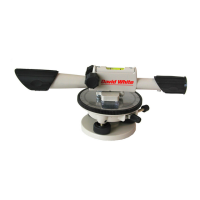-11-
This determines a second point on the
contour line. This step is repeated as
many times as necessary.
If the person holding the rod is moving
too far from the instrument, simply hold
the rod in one of the positions determined
from the original instrument position
and move the instrument to another
convenient location along the contour.
Sight on the rod in this position and move
the target up or down until it lines up
with the cross hair. The line may then be
continued in the same manner as before.
Measuring and Laying Out Angles
For measuring angles, attach a plumb
bob cord to the hook on the screwdriver-
style handle of the tripod. The point of
the plumb bob will then indicate a point
on the ground directly below the center
of the instrument and, therefore, will also
indicate the center of all angles to be
measured.
This point should be marked by a stake
about two inches square with a tack
indicating its center.
Remember, horizontal angles are always
read at the vernier zero mark.
The following example simply explains
how to measure angles:
- Set the instrument up at station 1.
Place it so the plumb bob is directly
over station 1.
- Now level the instrument as explained
previously.
- Turn the telescope so that the vertical
cross hair is directly in the center of the
rod at station 2.
- Set the horizontal circle at zero to
coincide with the vernier zero.
- Then turn the telescope to sight on
station 4 and read the angle. (In this
case, it would be 120 degrees.)
Move the instrument and tripod to station
2 and level exactly as before. When the
instrument has been leveled, sight back
to read on station 1.
- Set the horizontal circle to zero, then
sight the telescope to locate station 3
and read the angle (90 degrees).
- Move the instrument and tripod to
station 3 and level as before. Again,
sight back to the previous station (2)
and set the circle at zero.
- Turn the telescope to sight on station 4.
Your angle should be 105 degrees. The
same procedure is followed to measure
the angle at station 4.
You can prove the accuracy of your
reading by adding the four inside angles
together because the total of the inside
angles of a quadrangle is always 360
degrees.
To lay out an angle, proceed in the same
way as in measuring an angle.
- Set the instrument at station 1, level it,
and set the circle at zero.
- Swing the telescope to the desired
angle and move the rod to intersect the
vertical cross hairs.
This establishes your angle.
NOTE: The L6-20 and LT6-900 have
horizontal verniers which read to 15-min
(1/4 degree). For projects which need
more accurate angle measurement for
layout, we recommend using a more
precise instrument with a 5-min vernier.

